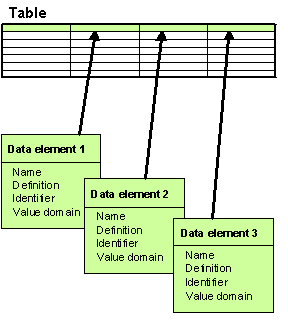Concepts & terms - datasets, tables, data elements
Datasets
In Reportnet and DD's context a dataset is a collection of tables containing the reported data. Often the "tables" will actually recede to a single table only. In a way DD datasets are stand-alone databases. Usually they come as MS Access databases or MS Excel files. They are subject to certain data flows and obliged to be reported by Reportnet players according to legislation. In many cases a dataset corresponds to a dataflow. For example there is the CDDA dataset defined in DD, which contains the information about reported data within that same-named data flow
Tables
A table in DD's context is a table in dataset. Columns in a table stand for data elements, rows stand for their values.

Data elements
A data element in Data Dictionary's context is a column in a table. The figure above provides a visual representation of what a table and its elements (columns) are.
On the highest level there are two classes of data elements in DD:
- non-common elements belong into a certain single table and they cannot be used in any other tables. They are defined within that certain table and they do not have a life outside of that table.
- common elements do not belong into a certain single table. They can be used in many tables, i.e. they can be part of many tables. You could also call them harmonised elements. They are potential candidates to be used in many datasets and tables and thus have been harmonised to avoid repetitions. A perfect example of a common element is for example CountryCode. It is obvious that CountryCode is probably needed in all datasets and many tables.
Data elements could be for example StationCode, StationType, Longitude, etc. And while Longitude can be measured and StationCode could be anything, StationType would probably have values from a pre-fixed set. These differences represent the 2 distinct data element types that DD recognizes:
- Element with fixed values (aka allowable values or code lists)
An element where predefined values are the only accepted values. In ISO 11179 terms referred as "characteristic 1" or "characteristic of type 1". - Element with quantitative values (aka measured values)
An element that can have any values within the element's data type. In ISO 11179 terms referred as "characteristic 2" or "characteristic of type 2". DD enables to define suggested values for these elements.
Attributes
Datasets, tables and elements in DD are defined by a set of attributes, the core set of which corresponds to ISO 11179 standard for describing data elements. The rest of the attributes are usually specific to Reportnet business rules and in any case the attribute set is flexible- an administrator can dynamically add/remove attributes to/from the system. Most common attribute of all is 'Name', standing for the name of the defined object. Other attributes could be for example 'Definition', 'Version', etc. There are two types of attributes recognized by DD:
- Simple attribute
Every such attribute in its instance is a name/value pair. They represent the same concept of attribute as in ISO 11179 part 3. For example the mentioned 'Name', 'Definition' and 'Version' are a good examples of simple attributes. NB! Note that simple attributes can have pre-fixed sets of allowable values, just like the elements. Often these values are some kind of codes. - Complex attribute
A complex attribute in DD's context is almost the same as a simple attribute. The difference is that while a simple attribute is a name/value pair, a complex attribute is a set of name/value pairs. Every such pair is called a field. For example address would consist of country, city and street fields. A set of these fields combines a complex attribute value row. The set of these rows is what is called the complex attribute's value.
- Datatype
Indicates if the element's values are strings, integers, booleans, etc. Also specifies if decimals are to be used, and how many decimals are accepted. - MaxSize/MinSize
The max/min length of a data element value in terms of digits or characters. For example if an element's MaxSize is 4, its value 'hello' is one char too long. Or if an element's MinSize is 5, its value '146' is one digit too short. - MaxValue/MinValue
Can be applied only to data elements of numeric Datatype and limits the element's numeric value. i.e. value '9.55' is too much if MaxValue is '9'.
- SubmitOrganisation
The organisation that has added or changed the data element definition. This is mandatory to specify for all dataset, table and element definitions! - RegistrationAuthority
Institution authorised to register the data definitions.
You can learn more about each and every attribute through using the DD, because each and every attribute in the DD user pages is provided with online help about its meaning and point.
European Environment Agency
Kgs. Nytorv 6, DK-1050 Copenhagen K, Denmark
